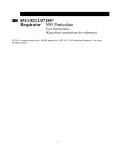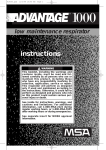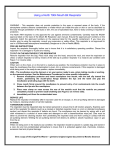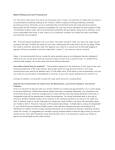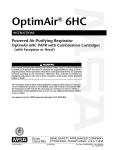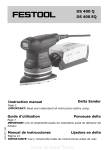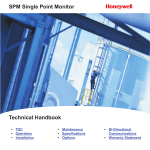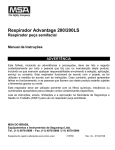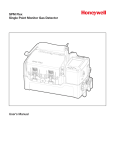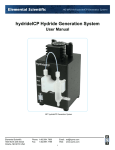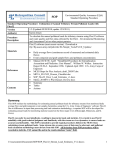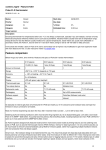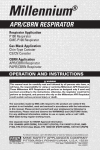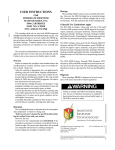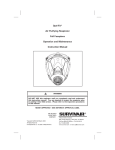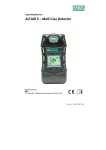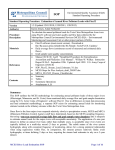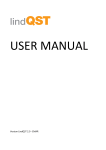Download MSA Comfo Classic Instruction Manual
Transcript
NIOSH APPROVAL INFORMATION Cautions and Limitations A- Not for use in atmospheres containing less than 19.5 percent oxygen. B- Not for use in atmospheres immediately dangerous to life or health. C- Do not exceed maximum use concentrations established by regulatory standards. H- Follow established cartridge and canister change schedules or observe ESLI to ensure that cartridges and canisters are replaced before breakthrough occurs. J- Failure to properly use and maintain this product could result in injury or death. K- The Occupational Safety and Health Administration regulations require gas-proof goggles to be worn with this respirator when used against formaldehyde. L- Follow the manufacturer’s User Instructions for changing cartridges, canisters and/or filters. M- All approved respirators shall be selected, fitted, used, and maintained in accordance with MSHA, OSHA and other applicable regulations. N- Never substitute, modify, add, or omit parts. Use only exact replacement parts in the configuration as specified by the manufacturer. O- Refer to User’s Instructions, and/or maintenance manuals for information on use and maintenance of these respirators. P- NIOSH does not evaluate respirators for use as surgical masks. S- Special or critical user’s instructions and/or specific use limitations apply. Refer to User’s Instructions before donning. S - SPECIAL OR CRITICAL USER INSTRUCTIONS Mixture of Contaminants NIOSH allows this respirator to be used for protection against a mixture of contaminants that are present simultaneously, or alternately, against one contaminant then another (using the same cartridges or filters) if the mixture meets the following conditions: • The cartridge/filter must be approved for all contaminants present. • NIOSH permits mixing of the following contaminants: Organic vapors, sulfur dioxide, chlorine, ammonia, methylamine, chlorine dioxide, hydrogen sulfide, and hydrogen chloride. • Particulates can be mixed with any other particulate or any gas or vapor for which the cartridge is approved. • Contaminants present simultaneously must be below IDLH levels for the specific contaminants. If anyone contaminant in the mixture exceeds the IDLH concentration, then the entire mixture must be treated as IDLH and the respirator cannot be used (except for escape from particulates with the appropriate filter). • Mersorb and Mersorb-P100 cartridges can be used against a mixture of chlorine and mercury that are both present simultaneously, but cannot be used if alternating between mercury-contaminated atmospheres and chlorine-contaminated atmospheres. Mersorb and Mersorb-P100 respirators utilize an end-of-service-life indicator for use against metallic mercury vapor. The small area at the center of the inlet surface of each Mersorb cartridge, and the band around the side of each Mersorb-P100 cartridge, consists of chemically-treated paper. In use, as the paper is exposed to metallic mercury vapor, it changes from orange to brown. When the indicator color changes to brown, the cartridge is beginning to lose its effectiveness against metallic mercury vapor and must be replaced. Thus, the wearer has a constant, positive check on the condition of his cartridge. Time Use Limitation N- and R- series filters shall be limited to 8 hours of use (continuous or intermittent against particulates). [Service time can be extended by performing an evaluation in the specific workplace setting that demonstrates (a) that the extended use will not degrade the filter efficiency below 95% or (b) that the total mass loading of the filter is less than 200 mg.] 1. This device does NOT supply oxygen. Use only in adequately ventilated areas containing at least 19.5 percent oxygen. 2. This respirator must be used in conjunction with the proper chemical or particulate cartridges for protection against specific contaminants. 3. DO NOT use when concentrations of contaminants are unknown or immediately dangerous to life or health (IDLH). (See the respirator NIOSH approval matrix to determine if this device can be used for escape from those concentrations.) 4. DO NOT use when appropriate exposure limit (OSHA, PEL, NIOSH REL, ACGIH TLV, etc.) is not known or when it is below the odor threshold or any other established warning level for the contaminant. 5. Leave area immediately if: a. Breathing becomes difficult; b. Dizziness or other distress occurs; c. You taste or smell contaminant; d. You experience eye, nose or throat irritation. 6. Use strictly in accordance with instructions, labels and limitations pertaining to this device. 7. This respirator may not provide a satisfactory seal with certain facial characteristics, such as beards or large sideburns, that prevent direct contact between the skin and the sealing surface of the facepiece. Do not use this facepiece if such conditions exist. 8. Never alter or modify this device. 9. This respirator is for use by trained and qualified personnel only. Failure to follow this warning can result in serious personal injury or death. RESPIRATOR USE LIMITATIONS The wearer must comply with the following MSA respirator use limitations: 1. Maximum Use Concentration (do not exceed any of the following): a. 10 times the exposure limit for the contaminants present. b. Immediately dangerous to life or health (IDLH) concentration for any contaminant present. 2. Do not wear for protection against substances with poor warning properties or those which generate high heats of reaction with sorbent material in the canister. 3. Do not wear for protection against the following contaminants regardless of concentration or time of exposure. This far-from-complete list is offered only as a guide to proper evaluation of the many contaminants found in industry. Contact MSA for further information on other specific materials. Acrolein Aniline Arsine Bromine Carbon monoxide Diisocyanates Methyl bromide Methyl chloride Methylene chloride Nickel carbonyl Nitric Acid Nitro compounds: Phosgene Phosphine Phosphorous trichloride Stibine Sulfur chloride Urethane or other Dimethyl sulfate Nitrogen oxides Hydrogen cyanide Nitroglycerin Hydrogen selenide Nitromethane Methanol Ozone diisocyanate containing paints Vinyl chloride DO NOT use for urethane paints or other paints containing diioscyanates because of their poor warning properties. Use against such contaminants could result in serious or permanent damage to the respiratory system. Use Air-Supplied Respirators. Failure to follow these warnings can result in serious personal injury or death. 4. GMT cartridge users are limited to 10 mpca for a maximum of 60 minutes and must use the cartridges immediately after opening the bag. EXPOSURE LIMITS A listing of acceptable exposure limits from the following sources is provided on MSA‘s website at www.MSAnet.com: • American Conference of Governmental Industrial Hygienists (ACGIH) • Occupational Safety and Health Administration (OSHA) • National Institute for Occupational Safety and Health (NIOSH) • American Industrial Hygiene Association (AIHA) Contact MSA at 1-800-MSA-2222 for information. respirators instructions This booklet, including the warnings and cautions inside, must be read and followed carefully by all persons who use or maintain this product, including those who have any responsibility involving its selection, application, service, or repair. This respirator will perform as designed only if used and maintained according to the instructions. Otherwise, it could fail to perform as designed and persons who rely on this product could sustain serious personal injury or death. For any additional information, call 1-800-MSA-2222 during regular working hours, or 1-800-MSA-5555 after working hours or during emergencies. See NIOSH insert for approval information. Exposure Limits for Mixtures The American Conference of Governmental Industrial Hygienists (ACGIH) publishes the following information to determine the TLV of a mixture. TAL 709 (L) Rev. 4 First determine the total concentration of the chemical mixture (CMixture) from the individual contaminant concentrations (C1, C2, C3, ...) Using the following formula: CMixture = C1 + C2 + C3 + ... The TLV of the mixture is found by using the following formula where T1, T2, T3, ... are the individual contaminant TLVs and C1, C2, C3, ... are the individual contaminant concentrations: Only use these equations if the contaminants present are actually mixed. Some substances do not mix and may be present separately, for example, in pockets or at different levels. In that case, the lowest TLV of the substances present must be used to determine the appropriate respirator category for protection against all contaminants present. See MSA’s website at www.MSAnet.com for additional information. RESPIRATOR FIT TEST A qualitative or quantitative respirator fit test must be carried out for each wearer of this respirator to determine the amount of protection it will provide. Respirator fit tests are explained fully in the American National Standard for Respiratory Protection, ANSI Z88.2, which is published by the American National Standards Institute, 11 West 42nd Street, New York, New York 10036. © MSA 2007 Prnt. Spec. 10000005196 (G) Mat. 818185 Doc. 818185 QUANTITATIVE TEST — If a quantitative fit test is used, a fit factor that is at least 100 shall be obtained before that respirator is assigned to an individual. QUALITATIVE TEST — If a qualitative fit test is used, only validated protocols are acceptable. The individual must pass a test designed to assess a fit factor of at least 100. The user must perform a respirator fit test and follow all warnings and limitations specified. Failure to do so can result in serious personal injury or death. TO CHANGE CARTRIDGES STANDARD COMFO CLASSIC CUSTOM FACEPIECE ASSEMBLIES Part No. 808057 808075 808059 808072 808053 808074 808055 808071 808061 808076 808063 808073 Small Model 7-201-2 • • • • Size Medium Model 7-201-1 Rubber Large Model 7-201-3 Hycar Headbands Silicone • • • Elastic Cradle • • • • • • • • • • • • • • • • • • • • • • • • • • • • • PROBED COMFO CLASSIC CUSTOM FACEPIECE ASSEMBLIES CLEANING AND DISINFECTING The facepiece (with the canister removed) should be cleaned and disinfected after every use with MSA’s Confidence Plus® Cleaning Solution (P/N 10009971). 1. Make a solution following the instructions. 2. Immerse soiled equipment in the solution and clean gently with a soft brush until clean. Take care to clean the exhalation valve in the facepiece and all other parts that exhaled air contacts. 3. Rinse in plain warm water (maximum 110°F.) and then air-dry. None of the metal, plastic, rubber, leather, cloth, or glass parts will be adversely affected by the cleaning solution. Part No. 808253 808256 808255 808258 808247 808250 808249 808252 808259 808262 808261 808264 Small Model 7-201-5 • • • • Size Medium Model 7-201-4 Rubber Large Model 7-201-6 Hycar Headbands Silicone • • Cradle • • • • • • • • • • • • • Elastic • • • • • TO CHANGE FILTERS ( Pad style with P/N 489353 Cover or P/N 816285 R95 Filter with P/N 489219 Cover) Filters must be replaced when excessive breathing resistance is encountered when inhaling, or when the Time Use Limitation is reached (see Special User Instructions). To change filters, unsnap the covers. Remove the used filters and dispose of them properly. Check the cover for dirt or damage. • • • • • Put a clean filter into the cover. Always use MSA replacement filters. Ensure that the edge of the filter lies flat in the cover. *Headbands are also available in rubber. Probed facepieces are for use while performing quantitative facepiece fit tests. Probed facepieces are not recognized by NIOSH as approved respirator components. Snap the cover (with filter) onto the cartridge. Be careful not to damage the filter. HOW TO DON & FIT THE COMFO CLASSIC RESPIRATOR If you are using a filter only, snap the cover (with filter) on the receptacle. Be careful not to damage the filter. Never load the filter into the receptacle. The P/N 816285 R95 filter can be used on cartridges only. CHECKS DONNING AND DOFFING Look for breaks or tears in the headband material. Also stretch to check the snap (elasticity). To put on the respirator, place the facepiece over the bridge of your nose and swing the bottom in so that it rests against your chin. Pull the headband over your head so the cradle straddles the crown of your head. ! Cleaning and Disinfecting at or below 110°F will avoid possible overheating and distortion of parts of the respirator assembly, which would require replacement. Grip as much of the cartridge receptacle as possible, then thread the cartridge into the receptacle. Hand-tighten so there is a good seal with the gasket in the bottom of the holder…but don’t force it. If the cartridge won’t go in easily, back it out and try again. • • • • • • • Check new cartridges for dents or other damage, especially to the metal bead around the bottom. Always use MSA replacement cartridges. • SERVICE LIFE INDICATOR The Mersorb and Mersorb-P100 respirators utilize an end-of-service-life indicator for use against metallic mercury vapor. The small area at the center of the inlet surface of each Mersorb® cartridge, and the band around the side of each Mersorb-P100 cartridge, consists of chemicallytreated paper. In use, as the paper is exposed to metallic mercury vapor, it changes from orange to brown. When the indicator color changes to brown, the cartridge is beginning to lose its effectiveness against metallic mercury vapor and must be replaced. Thus, the wearer has a constant, positive check on the condition of his cartridge. Cartridges must be replaced when the wearer detects the odor or taste of gases or vapors, or experiences nose or throat irritation, or, for Mersorb or Mersorb-P100 cartridges, when the end-of-service-life indicator changes to a brown color. To change cartridges, unscrew the used cartridge and dispose of them properly. Make sure all headbands, fasteners, and adjusters are in place and not bent. Check the facepiece for dirt, cracks, tears, or holes. The rubber should be flexible, not stiff. Fit the respirator on your face and fasten the bottom strap around your neck. Don’t twist the straps. Use the metal slides to tighten or loosen the fit…but not too tight. Look at the shape of the facepiece for possible distortion that may occur if the respirator is not protected during storage. To remove the respirator, use the metal slides to loosen the facepiece and gently pull the headband off. To check the exhalation valve, unsnap the cover. Lift the valve and inspect the seat and valve for cracks, tears, dirt, and distortion. FIT CHECKS MAINTENANCE This respirator must be kept in good condition to function properly. When any part shows evidence of excessive wear or damage, it must be replaced immediately with the proper part. Extra parts should be readily available. Refer to the Checks section for proper inspection of the respirator. This respirator, when not in use, should be stored in a clean, dry location. Do not distort rubber facepiece during storage. Replace the cover. It should spin freely. Also check both of the inhalation valves. Look for the same signs. To test the fit, lightly cover the exhalation valve with the palm of your hand. Exhale…If there is a leak, you will feel the air on your face. Check the aluminum yoke for cracks caused by too much bending. To spot weak points, look for black lines. Also test by covering the cartridges with the palms of you hands. Again, don’t press too hard. Inhale…the facepiece should collapse against your face. If there is a leak with either test, adjust the headbands or reposition the facepiece and test until no leakage is detected. The cartridge receptacles must be clean. Make sure the gaskets are in place and seated properly. The gasket has an outer beveled edge which sits under the threads. The gasket part number is located on the outer beveled edge and faces up. Check that the receptacle threads are not worn. Also look for cracks and other damage. For Additional Information Call: 1-800-MSA-2222 during regular working hours. 1-800-MSA-5555 after working hours. DO NOT enter any atmosphere with this respirator unless you know that: 1. You have read, understood and followed all instructions and warnings pertaining to the respirator. 2. The respirator and conditions meet the requirements outlined. 3. The cartridges are the proper type for the contaminant or contaminants present. 4. The amount of oxygen is sufficient to support life (that is, at least 19.5 percent oxygen by volume at sea level). Do not use if oxygen concentration sufficient to support life is questionable. 5. Respirator does not leak (see fit checks). 6. Cartridges do not need to be replaced. Discard exhausted cartridges. 7. You are not colorblind and can distinguish between the beginning and ending colors of the end-of-service life indicator (Mersorb and Mersorb-P100 cartridges only.) Failure to follow the above warnings can result in serious personal injury or death.


